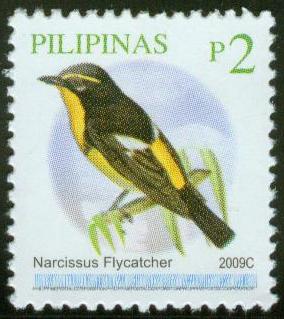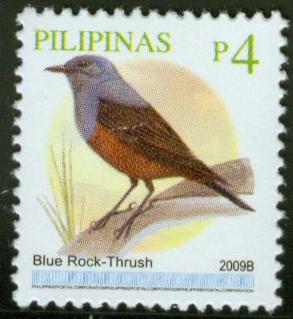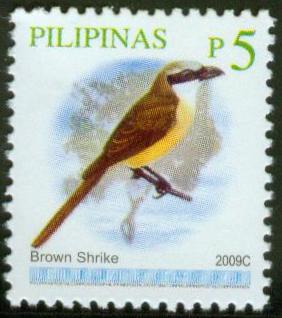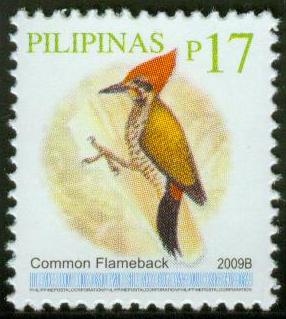2010, January 11. Philippine Birds - Definitives (New + Reprints)
Litho Offset. Amstar Company, Inc. Perf. 13.5; Perf. 14 (100p)
Singles, Sheets of 100 (10 x 10)
"2009" New Owl Designs



Se-tenant Blocks of Four (Marked "2009") (187,500)
24p - Philippine Eagle Owl
24p - Luzon Scops Owl
24p - Philippine Scops Owl
24p - Spotted Wood Owl
2009B Reprints:
4p - Blue Rock-Thrush - Singles (50,000)
17p - Common Flameback - Singles (25,000)
2009C Reprints:
2p - Narcissus Flycatcher - Singles (800,000)
5p - Brown Shrike - Singles (1,000,000)
Designs: All pictures taken from the book "A Guide to the Birds of the Philippines" by Robert S. Kennedy, Pedro C. Gonzales, Edward C. Dickinson, Hector C. Miranda, Jr., and Timothy H. Fisher.
First Day Covers: Manila
Many owls are associated with Minerva or Pallas Athene, the goddess of wisdom. She considered the owl a sacred bird, which gave the owl the reputation of having wisdom, and thus the saying “wise as an owl.”
24p - Philippine Eagle Owl (Bubo philippensis). The Philippine Eagle Owl is a vulnerable species of bird belonging to the Strigidae family. It is endemic to the Philippines, where found in lowland forests on the islands of Catanduanes, Samar, Bohol, Mindanao, Luzon, Leyte and possibly Sibuyan. It is known locally as the “kuwago” or “bukao”. With a total length of 40–50 cm (16-20 in) and a wing-length of about 35 cm (14 in), it is the largest owl in the Philippines, but among the smallest members of the genus Bubo. It is overall rufous with a lighter belly and yellow eyes. Little is known about the behavior of this secretive species, but the powerful feet suggest it feeds on small mammals and birds. This eagle-owl lays one egg per clutch and has an incubation period of 35 days (http://en.wikipedia.org/wiki/Philippine_Eagle-owl)
24p - Luzon Cops Owl (Otus longicornis). The Luzon Scops Owl is an owl is endemic to Luzon, Philippines. There are no sub-species. Scops-owls are Strigidae (typical owls) belong to the genus Otus. Approximately 45 living species are known, but new ones are frequently recognized and unknown ones are still being discovered every few years or so. Female scops-owls are usually larger than the males of their species, with owls of both sexes being compact in size and shape. All of the birds in this genus are small and agile. Scops-owls are colored in various brownish hues, sometimes with a lighter underside and/or face, which helps to camouflage them against the bark of trees. (http://en.wikipedia.org/wiki/Luzon_Scops-owl)
24p - Philippine Scops Owl (Otus megalotis). The Philippine Scops Owl is a common owl, endemic to the Philippines, belonging to the family of the typical owls Strigidae. It is one of the sixteen owl species in the Philippines. This owl grows to a length of 20 cm. Their big forward-facing eyes are dark with an orange-red rim. Their crown, ear tufts and feathers are dark brown, with dark streaks above. The facial disk has a dark rim. The forehead has a whitish pale color. They have big erect ears, as their name "megalotis" indicates. The Philippine Scops Owl lives alone or in monogamous pairs. They breed throughout the year, resulting in 1-2 eggs. (http://en.wikipedia.org/wiki/Philippine_Scops-owl)
24p - Spotted Wood Owl (Strix seloputo). The Spotted Owl has a body length of 16 - 19 inches, a 3 1/2 foot wingspan, and weighs 1 - 1 1/2 pounds. The Spotted Owl is closely tied to old-growth forests for nest and roost sites and the prey animals that live in this habitat. Spotted Owls are one of the few owls that have dark colored eyes. Most owls have eyes colored from yellow to red-orange.
(http://www.peregrinefund.org/Explore_Raptors/owls/spottedo.html)
-
Birds
